Knowledge
5 Things I Learned From The Strongest Gym In Canada
Articles, Strength and performance
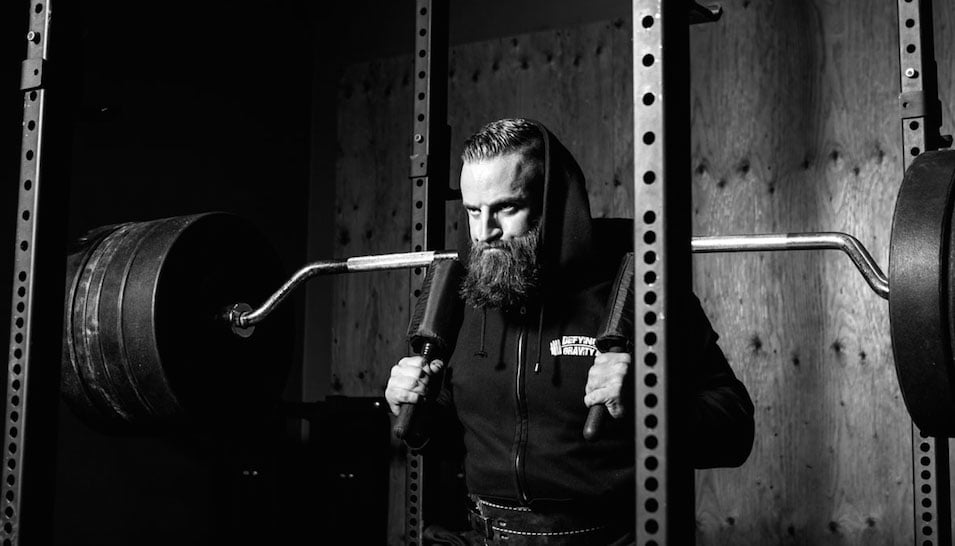
5 things I Learned From The Strongest Gym In Canada
I’ve trained in many great gyms in my life. I was also lucky enough to train around some super strong people. I’ve been to Dave Tate’s EliteFTS compound and saw three men squat over 960lbs in the same workout. I’ve trained alongside Jacques Demers, the last Canadian male Olympic medalist in weightlifting. And I’ve seen my fair share of 700-800lbs deadlifts.
There are a lot of great strength athletes in Canada. The province of Quebec is especially well represented in that department because strength has always played a very important role in our culture. You see, historically the English Canadians ruled the nation and pretty much controlled the economy while the French Canadians were associated mostly with the working class and the clergy.
For us, strength became one of the most respected attributes. For one, because a strong man was valued due to his aptitude as a laborer, but also because for the French Canadians, physical strength was a source of pride; strongmen became our heroes. Each village had its own strongman and stories.
With so many good strength athletes come many amazing gyms. One simply has to go to Fortis in Toronto to be in serious bad ass gym heaven or to hundreds of hard core pits around the country to be surrounded by true meatheads. But only one gym can boast being the strongest gym in the country, and quite possibly one of the strongest in the world.
That gym is “Santé X-treme” (http://www.gymsantex-trem.com/). How can I make such a claim, you might ask? After all, there are tens of thousands of gyms in the country, many of them boasting their own strong men and women.
Well, when the top three finishers at the national strongman championship train at the same gym (Jean-Francois Caron, Jimmy Paquet, Vincent Lapointe), that’s a pretty darn good start! But it’s not only that they have three great athletes, it seems like everybody is strong there! They have 18 people bench pressing at least 405 in legal powerlifting style, 15 guys squatting over 6 plates a side (585lbs), and 26 guys deadlifting over 6 plates per side, including four in the 800 and 900.
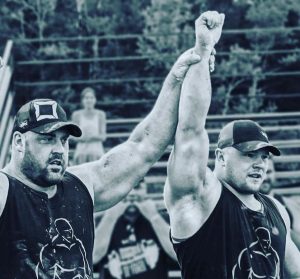
The group is headed by Jean-Francois Caron, the strongest man in Canada. JF has deadlifted 965lbs, squatted 900lbs and raw bench pressed 545 (and over 700 with a shirt). All raw. He also strict overhead pressed 400lbs and holds the world record in the tire flip, flipping a 1350lbs tire for 4 reps (https://www.youtube.com/watch?v=wFbPbhNXEAg)
And you know a gym is strong when the second-best in the gym is also the second-best in the nation; Jimmy Paquet, who is also starting to do well on the international scene. I’ve known Jimmy since he was a kid playing football. He always had an iron will and the desire to be strong. Now he backs it up with an 802lbs raw squat, 855lbs deadlift and 525lbs raw bench press as a 242lbs lifter who doesn’t even specialize in powerlifting! He is still just a kid, so I predict that this guy will be a superstar in the strength world.
Anyway, when you have so many strong people training at the same gym, you know that it’s because they are doing something right. Lucky for me (and you), Jean-Francois and Jimmy are friends of mine. I also coach them on the Olympic lifts and we get to talk training a lot, and I always learn some very important and applicable advice.
Here are the top 5 things I’ve learned from them.
- The tire flip and farmer’s walk are key elements of an effective program
They normally train strongman events twice a week. Sometimes more when they are preparing for an upcoming competition. Four different events are trained per session; could be Atlas stones, Log clean & press, loading medleys, Super Yoke, truck pull, etc. Anything you see in Strongman competition can be trained on that day, BUT two exercises are always trained during these workouts: Farmer’s walk and Tire flip. The other two events trained will vary from session to session but you’ll find these two every week.
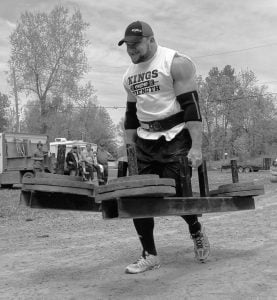
Caron believes that the tire flip is the best exercise to improve conditioning, something that not only strongmen competitors but also most type of athletes need plenty of. Not surprisingly he is the strongest “tire flipper” in the world and also one of the best conditioned and athletic strongmen on the circuit.
- The secret to big traps is …
When I trained Jean-Francois and Jimmy on the Olympic lifts what stood out the most were their traps. They both have traps that are bigger than most people’s legs!
Caron told me that a guy once asked him what was his secret for building big traps; likely expecting 5-6 new shrug variations. J-F answered: “Forces!”, which translates to “Lift heavy shit!” (in as slightly annoyed tone).
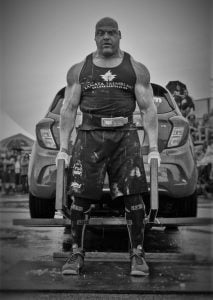
He has never done direct traps work (shrugs). What he does though, are heavy farmer’s walks every week and deadlifting for both max effort and fairly high reps; he did 6 reps with 790lbs and 11 reps in the low 700. He also trains the Olympic lifts a few times a week.
The moral of the story is if you want big traps you have to pull heavy. No amount of 45lbs shrugs can give you the same results as lifting and carrying big weights.
- “ Cinq ça travaille bien ”
Literally, “Sets of 5 work great”.
The one thing that came back a lot during my talks with the guys is that sets of 5 reps are what they use the most to build strength. And it has been a common theme in their training for as long as I can remember. When we both worked at the same gym (I was coaching the Olympic lifts, J-F was coaching strongman) 6 years ago, sets of 5 were his bread and butter. It is understandable though because in strongman you don’t need only “1 rep strength”, but sustainable strength since they often have to do multiple reps with a weight or carry weight for a certain amount of time.
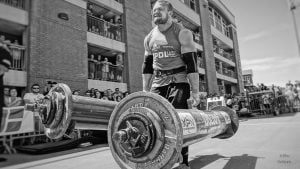
But it is also my own belief that sets of 5 will build more strength, especially in the intermediate lifter because it is heavy enough to train the nervous system but light enough to allow the volume necessary to stimulate tissue growth. Sets of 4-5 reps increase strength by improving both neural efficiency and muscle mass whereas sets of 1 and 2 mostly improve your capacity to demonstrate strength in a max effort but doesn’t really build muscle mass.
As far as weight selection goes, they prefer to stick to a fixed weight for all their sets of 5; but they can adjust it as they go along if a weight feels too easy. They want to challenge themselves on the sets of 5. They prefer to be forced to only do 4 reps on the last set then finish that last set thinking that they could have used a bit more weight.
Let’s say that they do 2 heavy lifts in a lifting session, they will focus on sets of 5, getting 3 or 5 sets of each exercise.
- The Caron max effort and volume combo
I mentioned that they do 3 or 5 sets of 5 reps on their big lifts. They do 3 when they train a specific movement for max effort. This combination is Caron’s favorite approach to improving a lift. What the crew does is gradually ramp up the lift of the day until they hit a solid maximum training single. Then they will decrease the weight to about 80-85% and perform 3 sets of 5 repetitions.
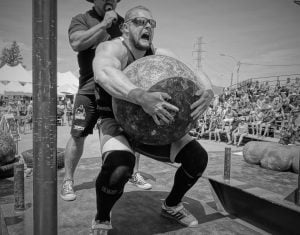
Again, for as long as I can remember this has been their go-to method to get super strong. A great approach that I adopted and adapted myself when I designed the layer system.
This combo is optimal for building strength because the heavy ramp up gradually amps up your nervous system, meaning that when you do your heavy sets of 5 you can use more weight and recruit more muscle fibers than if you started out with the sets of 5.
You also maximize neural adaptations when doing the singles and then stimulate muscle growth and fiber strengthening with the sets of 5. So the result is a much faster rate of strength gain.
The singles also help you better select your training weight for the sets of 5. On a day that you aren’t really strong on the singles it might indicate that you should also back off on the 5s as forcing yourself to go heavy on a day where your nervous system isn’t optimal might cause more stress which will delay your recovery and growth.
- Squatting and deadlifting twice a week
The Santé X-Treme Crew does something that used to be very popular but that you hardly see anymore: they do some form of squatting and pulling on the same workout, twice a week.
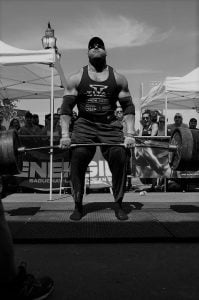
If their main strength lift is the back squat, they will use a deadlift variation as their second movement. For example, a pin pull from below the knees, or an axle deadlift.
If their main movement is the deadlift then the secondary exercise would be a squat variation like a front squat or a cambered bar squat.
Squatting and pulling in the same workout used to be the norm among strong guys. But you don’t see it as much nowadays. Probably because people are afraid of taxing their recovery (and lower back). But think about it: pretty much every Olympic lifter worth anything pulls and squats not only in the same workout, but in every workout! Most will do snatches, clean & jerks, pulls (snatch pulls for example) and a squat (front or back) several times a week, and they recover fine.
One could argue that doing both squats and pulls in the same workout twice a week might tax the lower back. Others would see it another way: the body adapts to everything and while it might be hard for a few weeks it will make the lower back that
much stronger over time. And with the list of strong dudes at the gym, it’s hard to argue! If you look at the top 3 guys at Santé X-Treme they all have both a very strong raw squat and raw deadlift. And incidentally, they also happen to be the top 3 strongmen competitors in the country (in a sport where a strong and healthy lower back is the most important thing).
Jean-Francois Caron with a 900lbs squat and 965lbs deadlift Jimmy Paquet with an 802lbs squat and 855lbs deadlift at 242lbs Vincent Lapointe with a 785lbs squat and 822lbs deadlift
Again these are not inflated numbers from wearing super space-age lifting gear, they are raw lifts.
This reminds me of when I went to Dave Tate’s EliteFTS compound. The crew did both heavy low box squats and heavy pin pull from below the knees. So it is certainly possible.
At one point we need to stop looking for justifications to be pussies and just work hard!
Bonus Tips
Do mobility work: Jean-Francois told me that he is always doing mobility work. At his size and with the amount of muscle he has, it is necessary to be able to do the movements properly and pain-free.
Less emphasis on the bench press: While they do bench press (Jimmy’s raw paused bench press of 525 at a body weight of 242lbs does indicate that they don’t neglect it) in their training it is not emphasized unless preparing specifically for a powerlifting contest. They put a lot more emphasis on the overhead lifts. Jean-Francois mentioned how focusing on the bench press hurts many of his movement by reducing shoulder mobility.
Eat!: The last session I coached them they literally mentioned their previous and next meals about 5 times. In fact, getting enough nutrition in seemed to be one of their primary concerns. It costs J-F 400$ per week on food alone (and I was complaining about spending 30$ per day on food) and it’s not crap either. Both Jimmy and J-F (I don’t know the other members personally) have never had a serious injury and I believe that mobility work and good nutrition plays a role in that. When I first met Jimmy, he was about 220, super lean. Looked like a more jacked model. He is now about 265. Still lean but not like he was. But he is willing to do what it takes to be the best.
A lot of guys who want to be super strong are afraid of putting on the weight because they want to keep looking good. I’m not saying you need to get sloppy, but trying to keep a beach body is a guarantee for slow progression and injuries.
Conclusion
I’m a pretty well-respected guy in the strength world. But even a guy like me needs to take a step back and listen when these guys are talking. After writing this article I changed my own training and started to focus more on sets of 5 (I normally stuck to 1, 2 and 3s) and introduced the max effort + volume combo for my main lift of the day. In two weeks, my Frankenstein squat from the bottom position went up 50lbs… something must be working.
Or maybe it’s just the tons of food!
— CT
STRONGEST GYM IN CANADA – BEST LIFTS
BENCH PRESS
over 3 plates (315lbs) :
- Kévin Gagné
- Frederick Rheaume
- Frederick Rheaume
- Mario Arcand
- Olivier Laperriere
- Xavier Pichette
- Maxime Miville
- Samuel Jean
- Martin Dumais
- Kéven Routhier
- Franco Rheaume
- Alex Robitaille
- Gabriel Tremblay
- Kevin Leclerc
- Jason Potvin (325)
over 4 plates (405lbs) :
- Kéven Labbé
- Mathieu Rail (455)
- Sébastien Villeneuve
- Guy Drapeau
- Vincent Lapointe
- Alex Lavoie Beaumont
- Stéphane Jean John Steph
- Kévin Potvin
- Guillaume Tremblay
- Antoine Picard-marchand (415)
- Jeffrey Elawani (405)
- John Morris Lapp (405)
over 5 plates (495lbs) :
- Keven Drolet (495)
- Guillaume Laflamme (505)
- Danny Boudreault (495)
- Jimmy Paquet (525)
- Jean-Francois Caron (545)
- Yanick Normandin
SQUAT
5 plates over (495lbs+)
- Kéven Labbé
- Max Miville
- Mathieu Rail
- Kévin Gagné
- Franco Rheaume
- Frederick Rheaume
- Gabriel Rhéaume
- John Steph
- Mario Arcand
- Guillaume Tremblay
- Olivier Laperriere
6 plates over (585lbs+)
- Keven Drolet
- Kévin Potvin
- Guy Drapeau
- Alex Lavoie Beaumont
- Alexandre Robitaille Bernard
7 plates over (675lbs+)
- Antoine Picard-Marchand (710)
- Jeffrey Elawani (712)
- Sébastien Villeneuve
- Guillaume Laflamme (705)
- Danny Boudreault (688)
- John Morris Lapp (675)
8 plates over (765lbs+)
- Vincent Lapointe (785)
- Yanick Normandin (765)
- Jimmy Paquet (802)
9 plates over (855lbs+)
- Jean-Francois Caron (900)
DEADLIFT
5 plates (495lbs+)
- Martin Dumais (573)
- Xavier Pichette (520)
- Olivier Laperriere
- Philippe Berthiaume
- Samuel Cantin
- Gabriel Matthews Tremblay
- David Bolduc
- Franco Rheaume
- Charles-Antoine Auger
6 plates (585lbs+)
- Maxim Miville
- Keven Drolet
- Gabriel Rhéaume
- Frederick Rheaume
- Mario Arcand
- Sébastien Villeneuve
- Keven Labbé
- Mathieu Rail
- Kévin Gagné
- Danny Boudreault
- Guy Drapeau
- John Steph (610)
- Alexandre Robitaille Bernard
7 plates (675lbs+)
- Kévin Potvin
- Antoine Picard-marchand
- Jeffrey Elawani (725)
- Steeve Boucher
- Guillaume Tremblay (700)
- Yanick Normandin
- John Morris Lapp (700)
- Sébastien Villeneuve
- Alex Lavoie Beaumont (675)
8 plates (765lbs+)
- Vincent Lapointe (822)
- Guillaume Laflamme (830)
- Jimmy Paquet (855)
- Jean-Francois Caron (965)